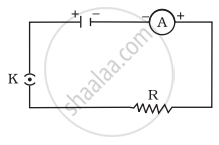Advertisements
Advertisements
Question
Match the following
| 1. | Cell | used to open or close a circuit |
| 2. | Switch | safety device used in electric circuit |
| 3. | Circuit | A complete path for the flow of an electric current |
| 4. | Miniature circuit Breaker | Reset by hand, circuit becomes complete once again |
| 5. | Fuse | A device which converts chemical energy into electrical energy |
Solution
| 1. | Cell | A device which converts chemical energy into electrical energy |
| 2. | Switch | used to open or close a circuit |
| 3. | Circuit | A complete path for the flow of an electric current |
| 4. | Miniature circuit Breaker | Reset by hand, circuit becomes complete once again |
| 5. | Fuse | safety device used in electric circuit |
APPEARS IN
RELATED QUESTIONS
Three resistors of resistances R1 , R2 and R3 are connected (i) in series, and (ii) in parallel. Write expressions for the equivalent resistance of the combination in each case.
One unit of coulomb is charge of approximately ______ protons or electrons.
Water can conduct electricity.
A cell, a resistor, a key and ammeter are arranged as shown in the circuit diagrams of Figure. The current recorded in the ammeter will be
 |
 |
 |
| (i) | (ii) | (iii) |
Electrical resistivity of a given metallic wire depends upon
Name the effect of current responsible for the glow of the bulb in an electric circuit.
Which of the following precautions need not be taken while using electric gadgets/appliances/circuits?
Which property of a conducting wire is utilised in making an electric fuse?
Why is an electric fuse required in all electrical appliances?
A torch is not functioning, though contact points in the torch are in working condition. What can be the possible reasons for this? Mention any three.
